Mining Methods
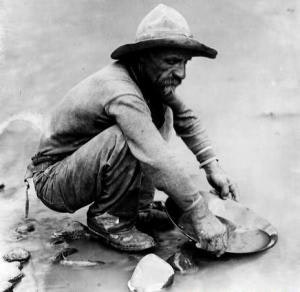
The Gold Rush is generally considered to be the period between 1848 and roughly 1860, during which time a flood of Argonauts entered California’s mining regions, prospected new areas, and eventually spread their activities to neighboring territories. The most enduring image of the gold rush is the eager, grizzled prospector kneeling alongside a stream with his pick and pan. Mining changed rapidly, however, from an individual endeavor to one based on group effort – hydraulic and drift mining - and, eventually, labor-and-capital industrial ventures – quartz lode mining.
Placer Mining
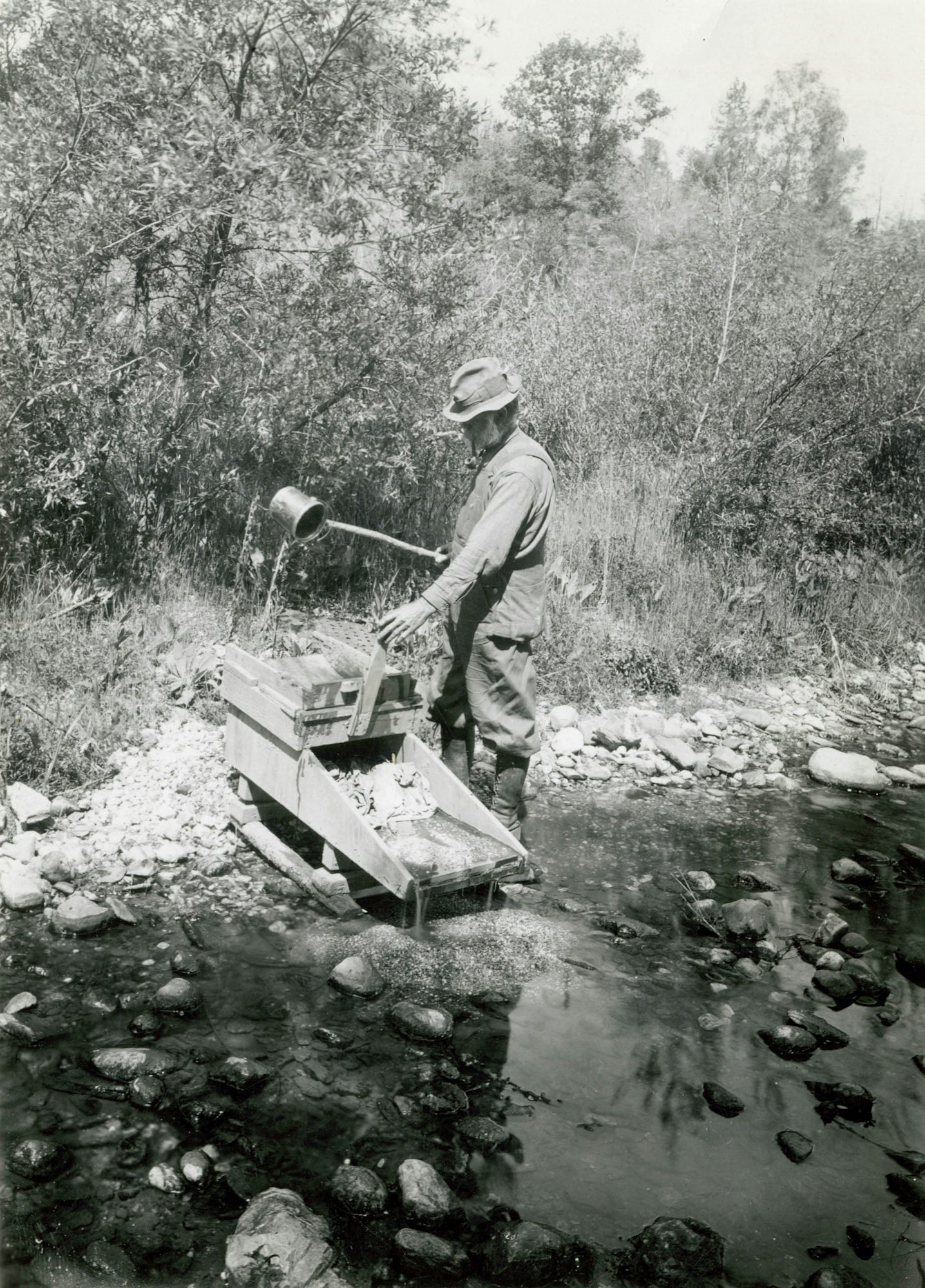
The Gold Rush period was dominated by placer mining for gold. It was not until hard rock or deep mining spread that other metals, along with gold, were mined. Placer mining refers to mining for gold that nature has freed from its associated rock and left in the form of nuggets, flakes, grains, or dust. Because this process was associated with erosion caused by water flow, gold found through “placering” was located in streambeds or in deposits left in ancient streambeds. During the Gold Rush period, placer mining was heavily dependant on manual labor and the use of water, so its mining sites are typically found along streams, in river canyons, or in tributary canyons. Typical mining equipment during the period included cradles, long toms, sluice boxes, and hand-held equipment (pans, picks, shovels, etc.). As the years passed, more elaborate methods of placer mining (river mining with dams and water-driven pumps, ditch-fed sluicing systems, booming and other nascent versions of hydraulicking, and sinking drifts into ancient gravels) gradually replaced the miner with his pick and pan.
The placer mining methods used in California had been known for centuries. They were employed by the Spanish in the New World, and by miners in Georgia and North Carolina in the 1820s and 1830s. Not surprisingly, miners from those regions were influential in providing information about mining techniques (largely by example) to the largely inexperienced miners of the early years of the Gold Rush (Brereton 1976, 286-302). These included use of the familiar pan (batea), cradle (rocker), long tom, and sluice box. Each was a refinement of the earlier – a cradle handled more auriferous material than did a pan (although a pan was often used as a final step), a long tom was more efficient than a cradle, and a sluice box more efficient (especially when linked in series) than a long tom. Each was eventually also more water- and capital-intensive to develop. Miners used these relatively simple methods to process surface placer deposits, usually near an available water supply.
Hydraulic Mining
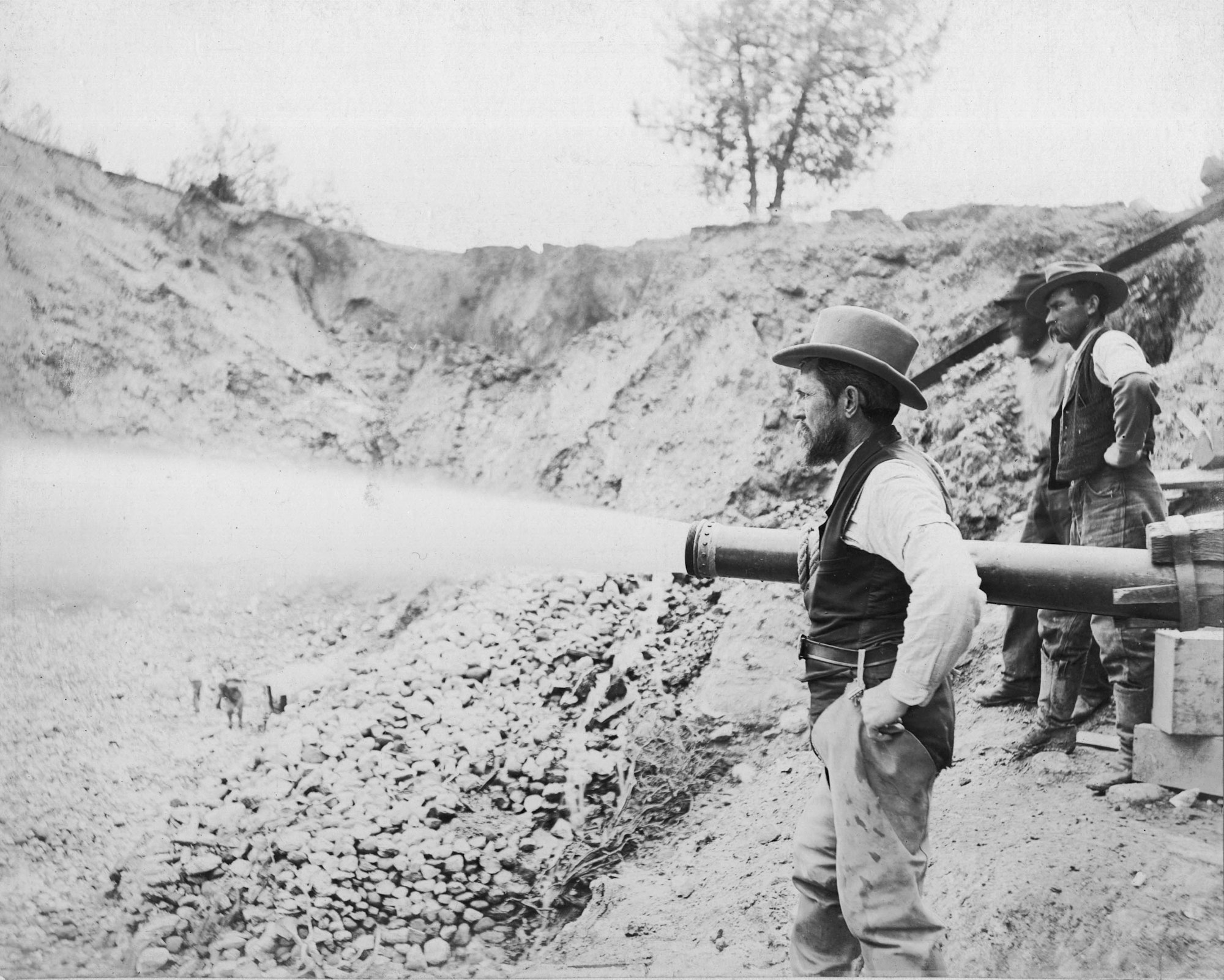
As the Argonauts learned about placer deposits, they turned to other methods that had more pronounced effects on the landscape. Miners quickly learned that rich placer deposits might be found in the Tertiary gravels left in the beds of ancient rivers in the mountains. Millions of years old, the gravels were the remnant deposits of ancient rivers that had run through the region at angles to the modern streams, and were marooned as the Sierra Nevada’s granitic batholith was uplifted and changed the drainage pattern. Getting at these gold-bearing gravels required application of significantly different methods because they were overlaid with non-productive deposits that needed to be removed. The result was development of two different methods: hydraulic mining and drift mining.
The advent of hydraulic mining was among the major improvements to placer mining methods. It was one that had profound effects on California’s environment, leaving lasting scars on the earth, debris in the canyons and rivers, and a complex network of canals and ditches that shifted water to mining areas remote from their sources. Hydraulicking also required the application of investment capital, and employed the paradigm of industrialism (hired labor, resources and services acquired from other companies, etc.).
Hydraulic miners employed water under great pressure to wash away the overburden, and to run gold-bearing gravels through elaborate systems of sluice boxes. The water cannons most often seen in historic photographs, called monitors or “giants,” were used to remove the “waste” or overburden; smaller monitors were used to wash the gold-bearing gravels into the mines’ sluice systems.
Hydraulic mining’s heyday was from the 1860s through the mid-1880s, when one of the nation’s first environmental lawsuits led to its strict control and, gradually, to its effective end. The main ditches feeding the hydraulic mines were typically eight to fifteen feet wide at the top, four to six feet wide at the bottom, and three or more feet deep. Steep hillsides and deep ravines were traversed with wooden flumes and heavy iron pipes 20 to 40 inches in diameter. These systems were often converted to use in the state’s hydroelectric generating systems after the hydraulic mining era passed (Logan 1981, 194). One of the most famous hydraulic mining sites has been preserved in the Malakoff Diggings State Historic Park; it represents a large example, but is by no means the only one in the region. In Calaveras County, the large and extensive hydraulic pits around Mokelumne Hill mark this type of mining.
Drift Mining
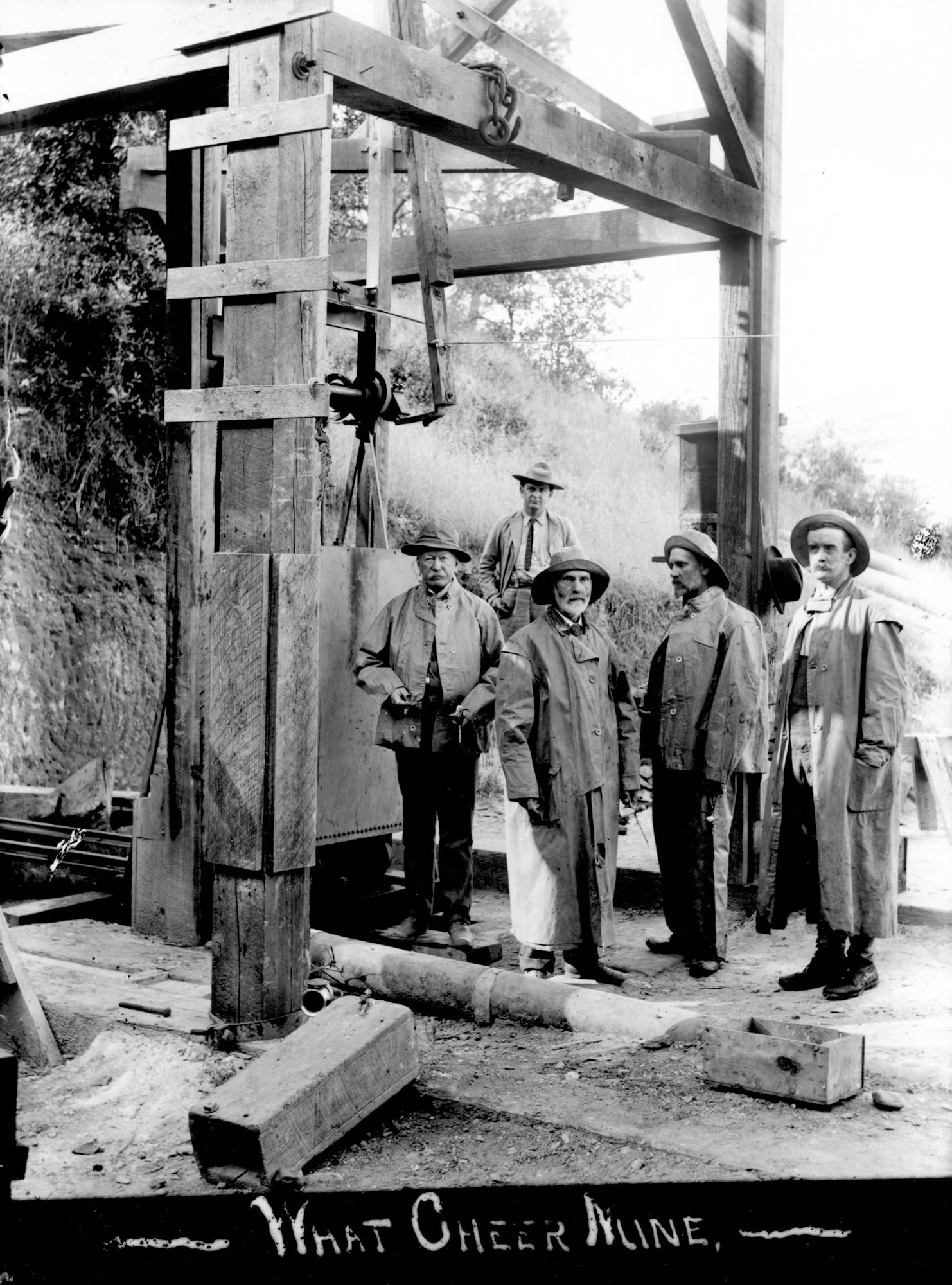
Drift mining, a variant method of exploiting the ancient gravels on high, dry hillsides, involved driving tunnels (drifts) into the gravel beds and then processing the extracted material. It was employed where the overburden was too deep for hydraulicking, or where water was less available. Drift mining took place under the lava cap on Table Mountain near Murphys and into the Tertiary deposits around Mokelumne Hill.
Dredging
The final refinement of placer mining was dredging. Successful dredges are largely a 20th century invention. Although unsuccessful efforts, particularly along the Yuba River, were made in the 1850s, attempts at early dredging were largely abandoned in California by the 1880s. Dredge mining fields were located low in elevation, typically where rivers or major tributary streams emerged from the mountains, such as around Jenny Lind in Calaveras County. The first successful bucket dredges in the United States appeared in Montana at Bannack in 1895. By the first decades of the 20th century dredging became efficient, profitable, and a big business; major investors in dredging companies were among the wealthiest people and corporations in the nation.
Dredging was less financially risky and more profitable than most forms of mining, because modern methods such as test holes could predict production levels with accuracy. A modern dredge would typically run 18 hours a day, seven days a week, on an industrial schedule. The companies maintained machine shops to keep the massive equipment in repair. By 1905 the dredges used a system of revolving screens and shaking tables to separate gold from sand and gravels. The dredges in these locations operated into the mid-1960s.
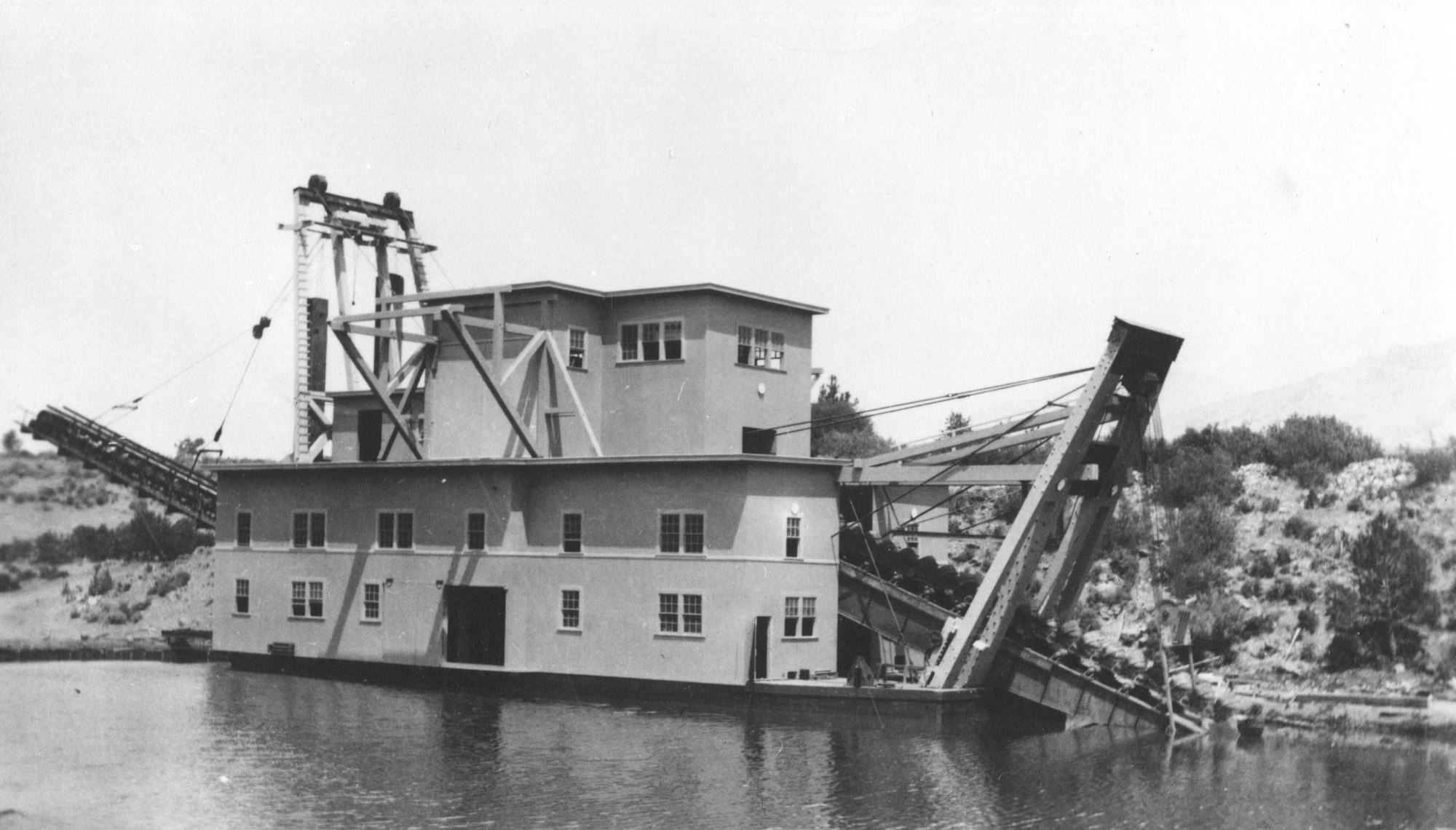
Such machines caused substantial damage to the environment. Mining historian Spence noted that tailing piles in long rows were the signatures of the industry. He also observed that, because their operation was largely before the era of environmental regulation and its wastes tended to be confined within the mining claim, the industry largely escaped serious regulation. These tailing piles were often mostly sterile gravels and cobbles on which vegetation was slow to grow; requirements for “resoiling” were defeated in court and largely ineffective when attempted. When dredging stopped in California, the available dredging equipment was largely disassembled and shipped to other gold fields around the world.
Quartz Lode / Deep Mining
Miners during the Gold Rush were quick to realize that gold existed in quartz veins, and attempted to mine it. As early as 1849, famed guide and trailblazer Kit Carson discovered the Mariposa Mine with its ore-bearing quartz. Early miners used arrastras and other simple mechanisms to try to release the gold from the rock in which it was found.

Quartz lode mining required the application of six general factors that, for the most part, most forms of simple placer mining did not. First, it required technical engineering expertise to design and build the physical plant for such a mine, both above and below ground. While at first this knowledge was often self-taught, as the years went on such expertise became more and more critical. Second, processing the ore involved the application of heavy equipment coupled with motive power. Ores had to be crushed to release their gold. Power for the crushers came from water wheels, compressed air, and later, electricity. Third, the ore often required chemical treatment, through the application of mercury, acids, cyanide, and other solutions, to release the gold from the compounds in which it was found. Fourth, these mines, particularly the larger examples, needed hired labor to operate; of course, this meant that the mine needed to meet payrolls no matter what the day-to-day yield of the veins brought the company. Fifth, as the years progressed, mining geologists became a requirement at major mines. Finally, the need for technical expertise, heavy equipment, chemical plants, and labor meant that mine owners needed ready access to financial markets and investors to fund development and operations. Investors needed surety that a mine’s claims were valid, and that its veins had potential yields to provide return on investment.
Quartz lode development did not experience a smooth upward path. By 1858 there were more than 280 stamp quartz mills, each supplied by one or more veins. But by 1861 only 40 to 50 were still in operation. Numbers fluctuated in the years that followed. Hand drills and black powder were common up to 1868, when miners and mining companies began converting to advancements such as power drills and nitroglycerine-based dynamite. It took decades before these became common. Rock crushers, like the Blake Crusher, were introduced in 1861. As mining historian C.A. Logan remarked, “the self-feeder, the rock breaker, heavier stamps, and increased running speed gave the stamps greatly increased capacity.” Likewise, the treatment of mine concentrates became more technologically advanced as the years progressed. By the 1880s the frue vanner and endless rubber belt vanners more efficiently concentrated the stamp mills’ output, along with mercury tables, and other equipment. The development of chemical methods such as chlorination, used in conjunction with such concentrators, increased the plants’ efficiency further. Chlorination was used until 1896, when the cyanide process came into the industry (Logan 1981:195-196).
From history by Rand Herbert, 2008 A Historical Context and Archaeological Research Design for Mining Properties in California. California Department of Transportation, Sacramento.
References
Brereton, Roslyn
1976 Mining Techniques in the California Goldfields During the 1850s. Pacific Historian 20 no. 3: 286-302.
Limbaugh, Ronald H., and Willard P. Fuller, Jr.
2004 Calaveras Gold: The Impact of Mining on a Mother Lode County. University of Nevada Press, Reno.
Logan, C.A
1981 History of Mining and Milling Methods in California. California Geology, September: 194.
Paul, Rodman W.
1965 California Gold: The Beginning of Mining in the Far West. University of Nebraska Press, Lincoln NB.

